Table of contents
- Record runs on salt The fastest place in the world
- Borderline experiences
- milestone
- Salt of life
- Info – far and white
- Interview with Denis Manning
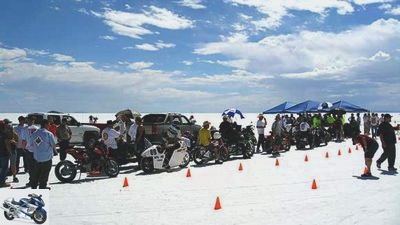
Haggling
motorcycles
Record runs on salt
Record runs on salt
The fastest place in the world
… is just a few miles past the lonely gas station with the cheap Mexican restaurant. The road ends behind it, just stop.
Michael Orth
09/26/2007
Where the road ends is a man in a cowboy hat. He points over the white plain and says: “Follow the trail of the toilets.” Quiet places lead to the fastest place in the world. The organizers have set up a good dozen brown Dixi houses especially for this purpose. They point the last few miles into the center of speed.
The man in the hat says: “The salt doesn’t carry anywhere. Away from the groomed stretches, it is sometimes so soft that even off-road vehicles dig in. So follow the trail. ”At the end of it, in the middle of the salt flat, spanned by a sky that stretches as far as to encompass the entire universe, is the paddock of the“ International Motorcycle Speed Trials ”. There are no more than three loose rows of pick-ups, mobile homes and trailers, in between sunroofs, sunroofs, sunroofs. By ten at the latest it is so bright that the light stings into the eyes as a white pain. And it’s so hot that you can drink four liters a day without peeing a drop.
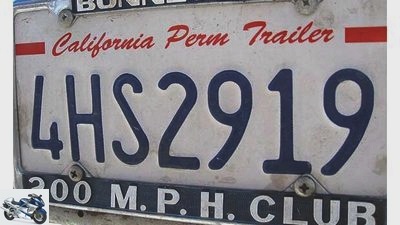
Schacher, Orth
The salt floor throws all the light back, and in the heat the contours of distant things become blurred as if on a shaky television picture. There would be nothing in this place if it weren’t for the speed. But because there is speed, nothing else is needed. “It’s such a fantastic feeling. It is pure beauty, a piece of your own heaven, there is only you, the machine and the salt. ”That is what Erin Hunter says shortly before she, in a barely knee-high streamlined motorcycle, stretched on her stomach and strapped with several belts, on the nine-mile-long Course drives. She smiles, very calmly.
Borderline experiences
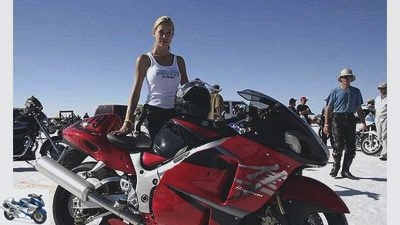
Schacher, Orth
Leslie has a motorcycle shop in Dallas and starts her Turbo Hayabusa in Bonneville.
Teammate Andy Sills looks after her, and when the machine disappears towards the horizon, the very small man with the very white, very broad grin says: “You know at that moment that everything will be yours all alone, and that will make your heart race . It may sound weird, but the hardest part for me is thinking about turning the gas back on. When you feel that speed is taking possession of you and this huge, wide, white area opens up in front of you, then it is infinitely difficult to slow down again. You are filled with a kind of peace. It takes your breath away. ”Santa Claus is standing in the shade under one of the sunroofs, scratching his beard. The yellow Buell doesn’t really want to. “It’s the electrics again. The salt goes in everywhere, preferably in the electrical system. But we can do that. And if not, then not. ”Santa Claus takes it easy, he has already broken so many records. His grandmother once said an important sentence to him. He made a note of that. “You got to give back,” she said and looked him straight in the eye: You have to pass on what you once got.
That’s what Santa Claus wants to do. He disappears into his van to look for something. His friend Pete says, “I’m sure he’ll get the trophy.” The trophy is a wooden board on which Pete and Tom Anderson, whom they just call Santa Claus in Bonneville, have attached a connecting rod. At the end of it is a completely ruined piston. “We got this from one of our previous engines,” explains Pete. The two raised 1,000 dollars. They want to give it away to the most successful team with the hand-made trophy. For them that means: the team with the greatest enthusiasm. “It’s not about the speed itself, not about the record itself,” says Pete when Santa Claus takes the trophy away. “Speeds and records are just numbers on a piece of paper. And then someone else comes along and drives faster. Even if a piece of paper is the only thing you have in hand at the end of the day, what you can achieve here cannot be written on any piece of paper in the world. “
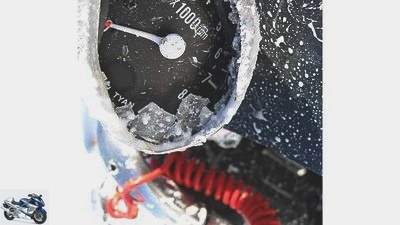
Schacher, Orth
One of the greatest, most important things that can be achieved on the salt is recognizing your own limits. Sometimes it happens very quickly. Last year, Rocky Robinson reached over 550 km / h in a streamlined machine. This time the speedometer at the first measuring point shows almost a hundred things less than the rear begins to lurch. Less than three seconds later, the machine overturns and draws a trail of blue paint almost a kilometer long before it comes to a standstill. Nose half torn off, shell splintered, salted down to the last nook and cranny. Robinson remains unscathed. He climbs out knowing it wasn’t his fault. It was the salt that will never be completely calculable for anyone, because it does not lie there like dead asphalt. “You have to pay close attention to what the salt tells you and you have to respond with the gas,” says one of the marshals as he collects the parts of the crash. »In 2006 we had salt like concrete, hard and motionless. Not this year. It’s changing all the time this year. It is alive, and no matter what you do: In this place, Mother Nature has the last word. “
milestone
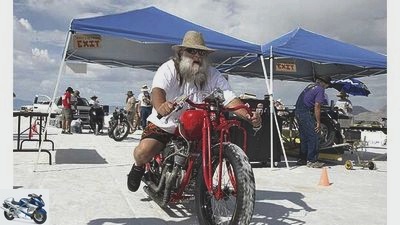
Schacher, Orth
Bonneville has become an important meeting place for the people who have been returning for tens of years.
Those who have been coming to Bonneville for tens of years in order to bring their own personal best maybe a mile or two closer to a completely unimportant official record know that very well. The people with the shaggy gray beards, the chapped hands and the dark edges under their fingernails, the people with the trucker caps or braided hats who used the welding machine to build a new frame for their very first motorcycle to bring it to Bonneville.
The »streamlined« panels were laminated over a self-carved wooden form. Which already burned about 100 pistons in the Bultaco two-stroke engine they’d found on the scrap metal. Moving the machines in this place that their fathers and grandfathers moved there. These people know that they cannot go against the salt, only with it. One of them, Ron Silverton, says, “It’s a bit like hard snow. You always have around 20 percent wheelspin, almost more like swimming on a motorcycle than driving. It is not unusual for the machine to lurch two or three meters to one side or the other. You have to let them run very gently. And keep your ears open. Your engine runs at full load for a very long time. You shouldn’t have been too lean. “
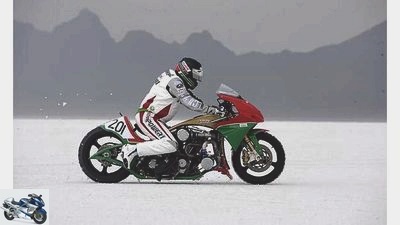
Schacher, Orth
After each run, the participants get a small piece of paper that says how fast they were.
For the optimal run on the salt a lot has to fit, and if you want to be fast at the fastest place in the world, you need one thing above all: patience. The line at the pre-start line is half a kilometer long before noon? first come, first go. Little by little they advance in the blazing sun until they arrive, sometimes after hours, in the shade of four blue tents, from where an official lets one participant after the other roll to the actual starting points. From there, the slower machines have two miles of start-up, the faster four miles, before the speed is measured at miles four and five. “You only have to be fast there,” says the starter.
“Otherwise things are very, very slow here in Bonneville.” They look like ants when they roll off the take-off, tiny dark dots in the white. No matter how fast or slow the dots get closer: Before they turn into motorcycles again, they send the sound ahead as the engine roars or roars or buzzes or screeches over the plain at full throttle. Often without damping, straight from the manifold. Even this sound, it carries with it something of what is going on in the helmet. Then the driver and machine can be recognized. They pass between the red flags that mark the lane, and each of them is down to their posture? small, crouched, so full of tension, motionless ?? to see how it rises in these seconds, how it loses itself in speed.
Salt of life
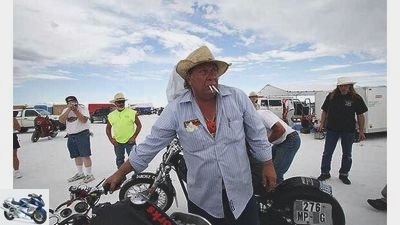
Schacher, Orth
Spectators and onlookers like to gather impressions here and be inspired.
Some have dedicated their lives to these seconds. In 1948 Marty Dickerson bought one “from those pretty ugly, but quick Vincent”. If he puts on his leather, which is as old and as black as his motorcycle, sits on the machine and approaches the first measuring point, then Marty is no longer 81. He is thirty years younger. So he, who set his first record on this motorcycle 56 years ago, drives the Vincent at over 150 miles an hour.
“Actually I had stopped doing it, but it didn’t work. And so I came back. ”Some may owe their lives to the seconds. In the early seventies, Pete and Tom, whom they all just call Santa Claus, stand in the jungle and say to themselves: “If we survive this, we’ll chase motorbikes over the salt.” A few months later they come home from Vietnam. Since then, they have met once a year. “Here in Bonneville, and we drive our motorcycles as fast as they can.” Still others, a great many on the Salt Flats, tell the story, see the film about Burt Munro’s life, see this man halfway around the world from New Zealand to Bonneville in 1967 comes and does what no one believed in, only he. You see Munro setting a record with his ancient Indian that still exists today.
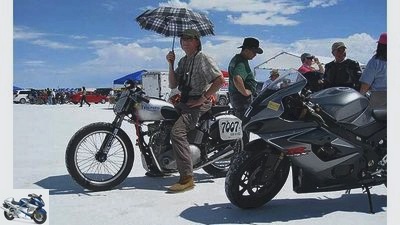
Schacher, Orth
This participant is his own patron.
“He was so calm, impressive. It was pouring rain outside. I said to Markus: I want to go on this lake too. ”Markus Saegesser looks at his friend Ruedi Steck as if to answer:“ I’m 51. I don’t know if I need that. ”But that’s exactly what happens when she does both Swiss have dispelled the first doubts. They realize they need it. So they build two machines, a three-cylinder Feuling and a supercharged custom Harley. You set up a racing team, find a sponsor, and practice at disused airports. One year after the rainy evening, they are actually on the Salt Flats, where, and so far nobody has managed that, they break a total of eight records as total newbies. * Ed Starrs has no plans to do that.
In the Run Watcha Brung class (100 dollars for two measured runs and go) he just wants to see what my mill has to offer. He is at the technical inspection when his buddy Rick comes back from his first run and shows him a slip of paper that attests to him 156 miles. “Nothing more?” Asks Ed. No, says Rick, but it was also “pretty wild. At mile three I had a front wheel slide, it went through the whole motorcycle, and the nuts were hanging in my throat «. Ed asks what he’s been doing and laughs. “What do you think?” Says Rick. “I swallowed hard twice and held on. I did this. Man, this is Bonneville, this is the fastest place in the world. I’m not slowing down there.
Info – far and white
In the 1830s, officer Benjamin Lewis Eulalie Bonneville roamed the American West. He did not walk over the 412 square kilometer salt flat on the border of Utah and Nevada. Nevertheless, it was named after him. A strip on the Salt Flats became a racing track in 1914 when Teddy Tetzlaff (no joke) drove it to almost 230 km / h in a Blitzen Benz. Since then, Bonneville has become the epitome of speed and what is known as land speed racing. Although it is anything but easy to get up to speed there. The grainy, loose salt crust offers only moderate traction, the monkey heat and altitude of 1,300 meters cost performance, and the weather is often capricious. That didn’t matter to the US Army: They tested the dropping of the atomic bomb in the area with dummies, and when the Enola Gay set out for the Pacific in July 1945 to destroy Hiroshima a little later, it took off from Wendover. This city has become tastelessness lies in the desolate nothing like a colored candy thrown in the dirt. But the garish casinos and shabby motels are the only places to stay in the immediate vicinity of the Salt Flats.
Interview with Denis Manning
The man behind the Motorcycle Speed Trials is called Denis Manning. He wears jeans with width 44. Ergo his nickname: Big Ugly Bastard, BUB. This is also the name of his company, which produces accessory exhaust systems in California. At speed for 40 years, BUB built his first record motorcycle in 1970. He also designed what is currently the fastest two-wheeler at 565 km / h, the BUB Number Seven.
What is this all about?
Speed! But it’s not about speed itself, but about speed as a passion of all of us. And it’s about the respect we have for one another here. No matter what you attach ?? it could be a Dixi toilet with which you announce that you want to drive 160 ??, you get support from everyone. That’s part of what makes Bonneville Bonneville.
And the other?
It’s like when you buy a magazine, open it, and it’s a little dirtier than you thought.
What is special about this type of race?
You are usually a winner if you finish first. It doesn’t matter whether your opponents had engine failure or fell on the face. It doesn’t work like that here. For the record, you have to be the fastest ever. Period.
Related articles
-
Triumph attempted to set a high-speed motorcycle record
markus-jahn.com 21 pictures markus-jahn.com 1/21 Picture gallery: motorcycle high-speed record attempt. markus-jahn.com 2/21 The whole technology is…
-
World record attempt with Vincent
Schermer Sports & scene Motorsport World record attempt with Vincent Scene: World record attempt with Vincent Hartmut’s Speed Date Content of There are…
-
IDM run in Most 2019: record and change in leadership
Dino Eisele Sports & scene Motorsport IDM run in Most 2019: record and change in leadership IDM run in Most Record and leadership change After twelve…
-
White Motorcycle Concepts WMC250EV: electric speed record
White Motorcycle Concepts 15th pictures White Motorcycle Concepts 1/15 White Motorcycle Concepts wants the world speed record for electric motorcycles….
-
New quarter mile sprint record with an e-motorcycle
True cousins 5 pictures True cousins 1/5 The Silver Lightning of the True Cousins racing team delivers 1,632 PS or 1,200 kW. True cousins 2/5 The…
-
World record ride with an electric motorcycle
fact 15th pictures fact 1/15 How far can an electrically powered series motorcycle go in Drive 24 hours? The Zero S covered 1,316.88 kilometers. That is…
-
Honda Mean Mower MK2 192 hp lawnmower on record run
Honda 17th pictures Screenshot of the Honda YouTube channel 1/17 Honda Mean Mower MK2 is the name of the Fireblade lawn mower from Honda. Screenshot of…
-
Elbow-down world record: 160 km-h fast, 30 meters wide
Fresh&Lean 6th pictures Fresh&Lean 1/6 US superbiker Josh Herrin has set a world record in elbow down. Fresh&Lean 2/6 He drove over a distance of 30…
-
A record attempt: 48,000 kilometers in 46 days
Sanders 15th pictures Sanders 1/15 The Dalton Highway runs endlessly through the solitude of the Yukon Territory. Sanders 2/15 Gigantic journey in record…
-
MOTORCYCLE archive motorcycles Our readers have voted Our readers have voted The ten most important motorcycles Regardless of whether you voted online,…